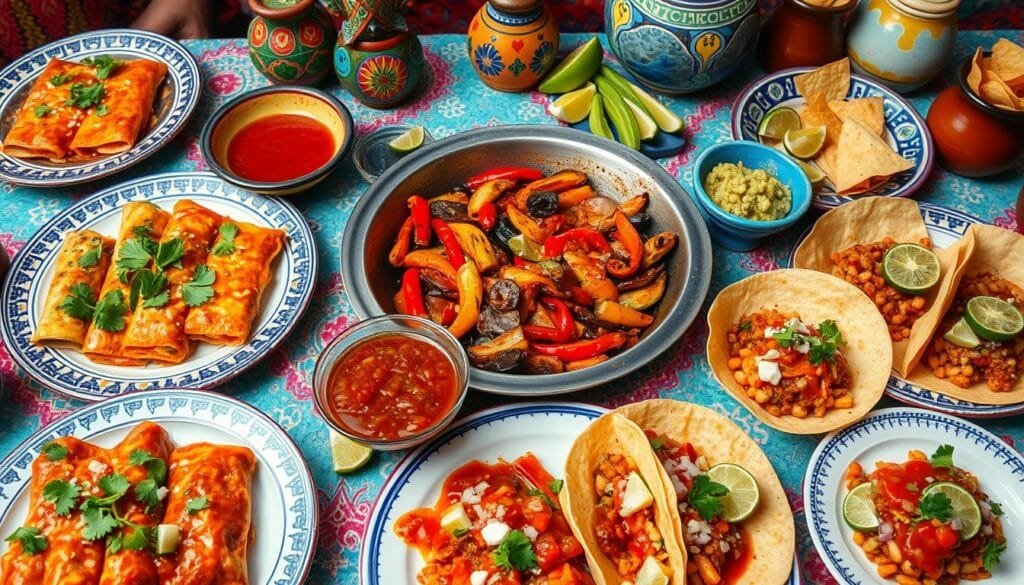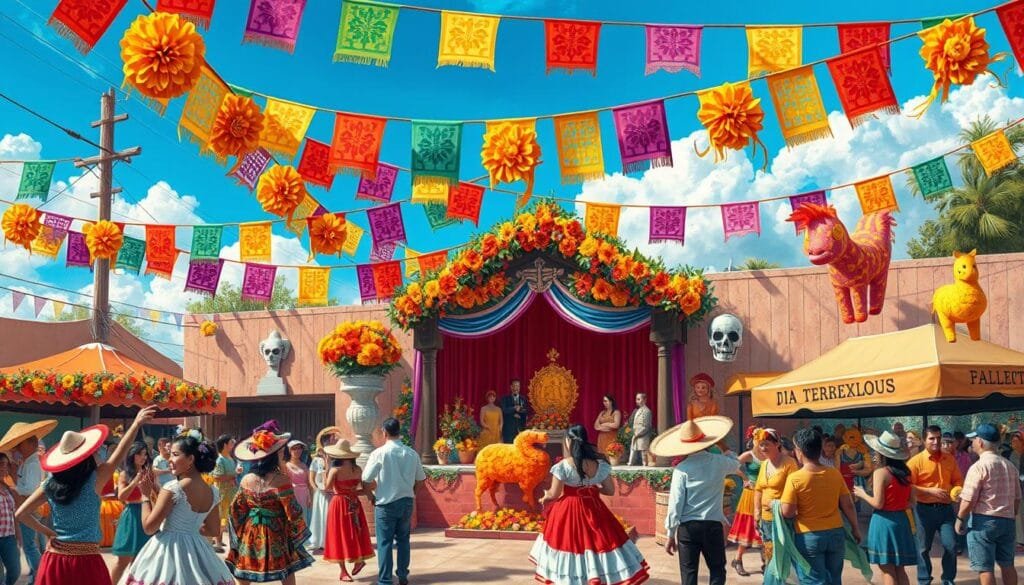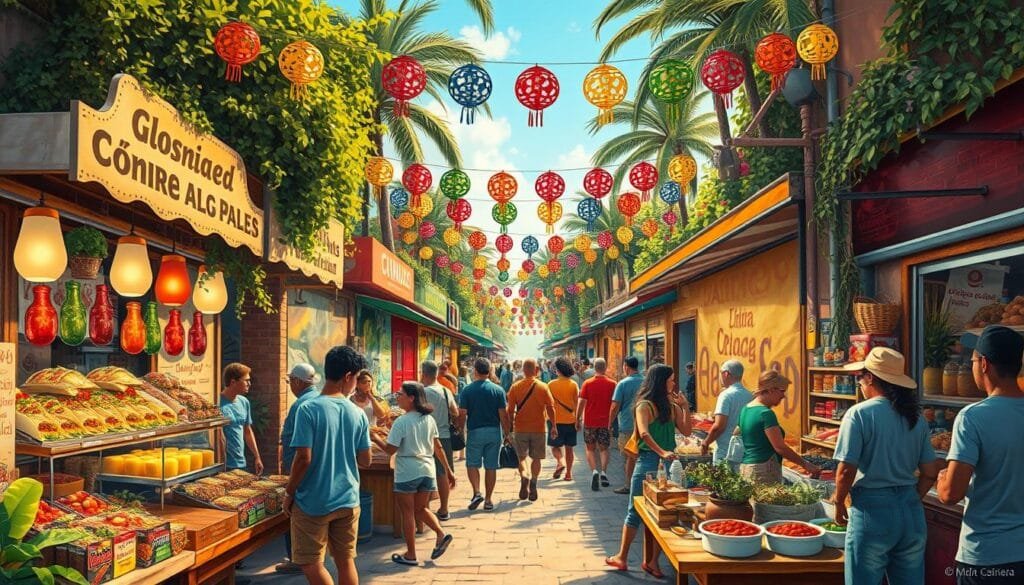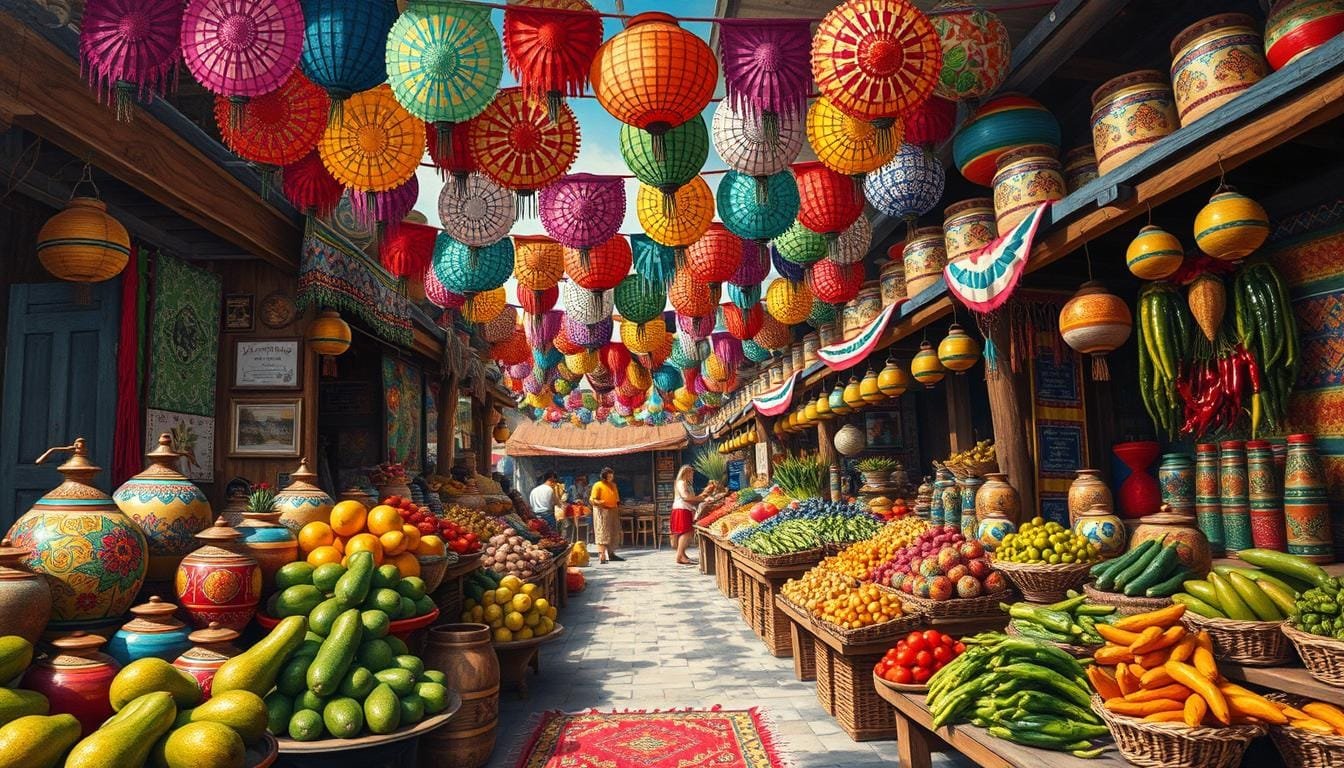Have you ever wondered why Mexican food, from tacos in Los Angeles to tequila in Tokyo, is so loved? Mexican culture’s rich influence goes beyond just taste. It shapes daily life and spreads globally, changing our celebrations and connections.
Mexican culture offers a rich mix of tastes and traditions. These influences tell important stories about history, identity, and community. Through food and festivities, Mexican cuisine shows its global impact.
The rise of Mexican food worldwide shows a story of cultural blending. In the U.S., 85% of counties have at least one Mexican restaurant. This proves how Mexican cuisine builds bridges between cultures, with every taco or tequila sip.
Key Takeaways
- Mexican cuisine is a globally beloved phenomenon, influencing food trends and cultural practices worldwide.
- Social media often highlights cultural perceptions and ethnic discussions related to culinary traditions, including *#slopgate* controversies.
- The rich history and diverse ingredients of Mexican food position it alongside top global cuisines like Thai and Indian.
- Aggregate influence of Mexican food and culture reflects significant social cohesion and intercultural communication.
- The prevalence of Mexican restaurants across the U.S. underscores the palpable integration and popularity of Mexican cuisine.
- Food’s emotional connection emphasizes Mexican heritage’s role in forging and sustaining global culinary identities.
The Historical Influence of Mexican Cuisine
Mexican cuisine’s history is rich and spans millennia. It’s shaped by diverse cultural influences. Ancient civilizations, Spanish impacts, and modern flair have all made their mark.
Pre-Hispanic Era
The roots of Mexican cuisine reach back to the Pre-Hispanic era. Foods were mainly plant-based with indigenous ingredients. By 1500 BC, the Olmecs grew corn, beans, and chile peppers, essentials in today’s Mexican dishes.
The Mayans, by 250 AD, influenced Mesoamerican diets with squash, avocados, and tomatoes. The Toltecs refined them further. The Aztecs, starting in 1325, added avocados, chocolate, and more, creating a rich culinary base.
Spanish Colonization
In 1519, Hernán Cortés and his Spanish conquistadors changed Mexican food drastically. They introduced European ingredients and techniques. Livestock like pigs and chickens made meat dishes more common.
They also brought sugar cane and wheat, making the food more diverse. The mix of Mexican and Spanish ways created dishes like tostadas and flour tortillas.
Post Revolutionary and Modern Periods
After the revolution, Mexican cuisine kept evolving. The 1920s saw more Mexican restaurants in U.S. cities. Los Angeles and San Antonio became key places for this cuisine. The 1950s introduced Tex-Mex, blending Mexican dishes with American tastes.
Today, Mexican cuisine combines tradition and innovation. It’s enjoyed worldwide, with creations like sushi tacos and Mexican pizzas. Modern Mexican cuisine shows the deep link between Mexico’s food, history, and culture.
Vibrant Flavors of Mexican Cuisine
Mexican cuisine is a colorful festival of tastes. It combines vibrant and varied flavors. Across the world, people love its famous dishes.
Iconic Dishes
Mexican food like tacos, mole, and tamales wins hearts globally. Tacos mix different fillings, such as beef or fish. This shows Mexican cuisine’s flexibility. Mole combines spices with chocolate, showing native cooking skills. Tamales, made with masa and wrapped in corn husks, link us to past traditions.

Regional Specialties
Different areas in Mexico offer unique tastes. In the north, dishes often feature meat, like carne asada. The Yucatan Peninsula is known for using tropical fruits and spices in its dishes. Near the coasts, seafood is a major delight. In Oaxaca, famous for its “seven moles,” sauces are rich in history. These regional dishes deepen our appreciation of Mexico’s culinary wealth.
Celebrating Mexican Holidays and Traditions
Mexican holidays are known for their lively traditions. They stem from history and culture. These holidays, from September to February, fill the calendar with festivals. They show off food, religious rituals, and joy.

Dia de los Muertos happens on November 1st and 2nd. It is a major event that connects the living with the dead. Families create ofrendas (altars) with marigolds, candles, and the deceased’s favorite foods. Special treats like skull candies and Pan de Muerto are made. This celebration is significant, touching 70 million people in Mexico.
Cinco de Mayo is on May 5th. It marks the win over the French in 1862. It’s not about independence but holds cultural value, especially in Puebla. People enjoy parades, music, and dances, showcasing Mexican resilience.
Mexican Independence Day is on September 16th. The night before, people come together for the grito. This cry of freedom brings the nation together in pride.
Christmas time is pivotal for over 80% of Mexican families. It peaks at Nochebuena on December 24th. Families make traditional dishes that mix native and European tastes. About 50% participate in Las Posadas from December 16th to 24th. This event reenacts Mary and Joseph’s search for shelter.
On January 6th, Dia de los Reyes Magos creates family time. Everyone enjoys Rosca de Reyes, a special bread. Finding a Baby Jesus doll inside means hosting a party on Dia de la Candelaria on February 2nd. Families then eat tamales together, with 30 million tamales eaten nationwide.
These celebrations highlight Mexico’s unique cultural identity. They blend history, religion, and community through food and fun. Mexican holidays are not just national events. They invite the world to experience Mexico’s colorful and enduring traditions.
How Does Mexico Influence Food and Culture
Mexican culture has greatly influenced food around the world. Its flavors, ingredients, and cooking methods have reached many countries. Let’s explore how Mexican cuisine shows its magic globally.

Global Impact of Mexican Cuisine
Mexican food is loved everywhere, from New York to Tokyo. People enjoy tacos, mole dishes, enchiladas, burritos, and nachos that keep the taste of Mexico. Even with local twists, these foods stay true to their roots.
Salsa, which began in Aztec markets, is now a global favorite. The mix of native Mexican foods with Spanish influences like rice creates a special blend. This blend has gained recognition, such as the UNESCO Heritage listing, for its cultural importance.
Mexico’s history is alive in its food, reflecting ancient cultures like the Olmecs and Aztecs. The mix of indigenous and Spanish elements makes Mexican food important worldwide. It’s more than a meal; it’s a story of resilience and combination.
Mexican Cultural Practices Abroad
Mexican culture is celebrated in many countries. Holidays like Cinco de Mayo, Día de los Muertos, and Mexican Independence Day unite people. These traditions show the global appeal of Mexican culture.
Mexican crafts, music, and dances are loved across the world. They promote cultural appreciation and exchange. Also, tequila and mezcal introduce people to Mexico’s rich history and land.
In summary, Mexican cuisine and culture have a big impact globally. They enrich the world’s food and cultural scenes. Mexican traditions, from food to celebrations, are loved by many and show the culture’s global charm.
Conclusion
Mexican culture and its cuisine’s influence stretch across the globe, adding flavor and tradition everywhere. The history of Mexican food goes back to ancient times. It has grown through many periods such as the pre-Hispanic era and Spanish colonization. All these periods have made Mexican cuisine rich and diverse, loved all over.
We found the amazing variety in Mexican dishes and regional treats. They bring out Mexico’s unique flavors. Dishes like the complex moles of Oaxaca and fresh ceviches from the coast share stories of cultural mix and cooking creativity. Mexican holidays and traditions, like Día de los Muertos and Cinco de Mayo, show the cultural depth and joy shared by Mexicans and their fans worldwide.
Mexican culture is making its mark around the world. Its food and traditions are being shared far and wide, enriching different societies. This sharing helps us see how connected we all are. However, it’s caused good and bad changes in diets. The rise in obesity among Mexican Americans and unhealthy eating habits in the U.S. show the challenges of sharing cultures.
In wrapping up, honoring Mexican culture and its culinary legacy lets us enjoy Mexico’s rich history and food. It also helps us see its role in the wider world. By embracing Mexican traditions, we make our world more inclusive and tasty.
FAQ
How has Mexican culture impacted global food trends?
Mexican culture has brought rich flavors to the world through popular dishes. Tacos, mole, and tamales are loved globally. They share Mexico’s vibrant culinary traditions with people everywhere.
What are the main periods in the history of Mexican cuisine?
Mexican cuisine has three key periods. These are the Pre-Hispanic era, the Spanish colonization, and the modern era. Each period introduced new foods and cooking methods, shaping today’s Mexican cuisine.
How did the Pre-Hispanic era influence Mexican food?
In the Pre-Hispanic era, Mexicans ate mainly plants. Maize, beans, and chili were central to their diet. Wild game was the main meat source. These traditions are still seen in Mexican dishes today.
What changes did Spanish colonization bring to Mexican cuisine?
The Spanish brought livestock, which meant more meat and dairy in Mexico. They also introduced crops like sugar cane and wheat. These changes made Mexican food even more diverse.
How has modern Mexican cuisine evolved?
Today, Mexican cuisine mixes traditional elements with new ingredients and cooking methods. Thanks to globalization, we see an exciting variety of flavors and dishes.
What are some iconic Mexican dishes celebrated worldwide?
Worldwide, people love Mexican tacos, enchiladas, mole, tamales, and burritos. These dishes showcase the unique flavors and traditions of Mexico’s regions.
Can you name some regional Mexican specialties?
Regional favorites include northern Mexico’s carne asada and Oaxaca’s moles. Coastal areas are known for seafood. Each region offers something special, showing Mexico’s culinary variety.
What are some major Mexican holidays and traditions?
Big Mexican celebrations are Dia de los Muertos, Cinco de Mayo, and Independence Day. These events feature colorful parades, music, and dances, full of tradition.
How has Mexican cuisine impacted global culinary practices?
Mexican cuisine has made a big mark worldwide. From taco stands to Mexican restaurants, dishes like nachos and burritos have been embraced everywhere. This shows the global love for Mexican food.
What Mexican cultural practices have been adopted abroad?
Around the world, people celebrate Mexican holidays and enjoy Mexican crafts, music, and dance. These practices highlight Mexico’s rich culture and are cherished internationally.
